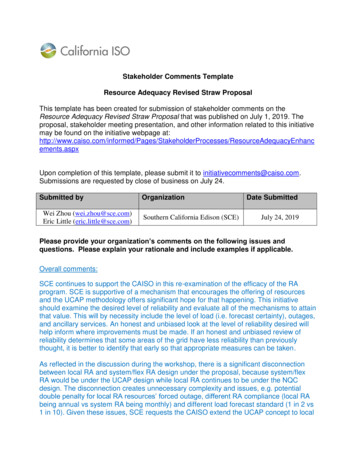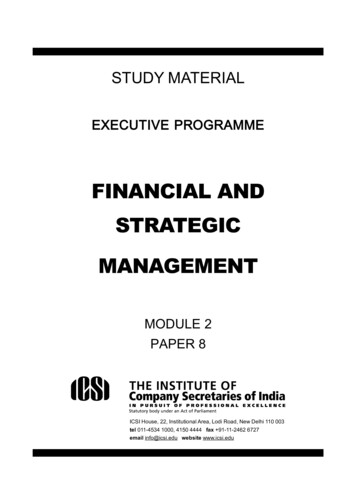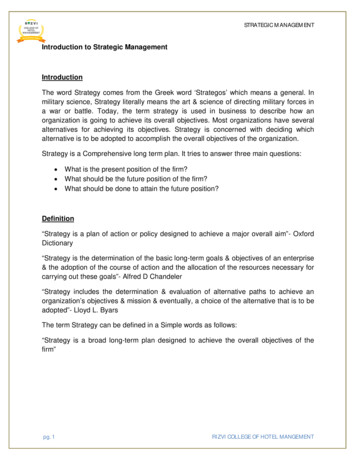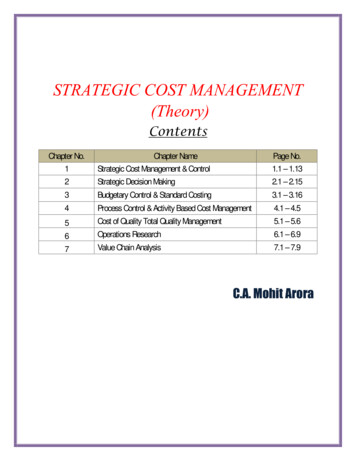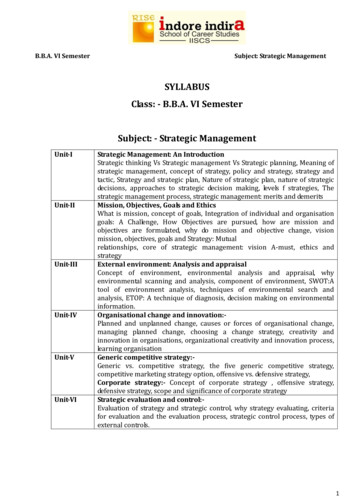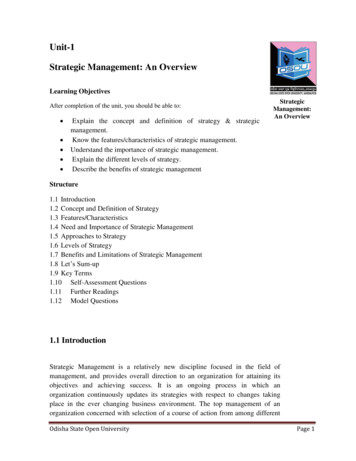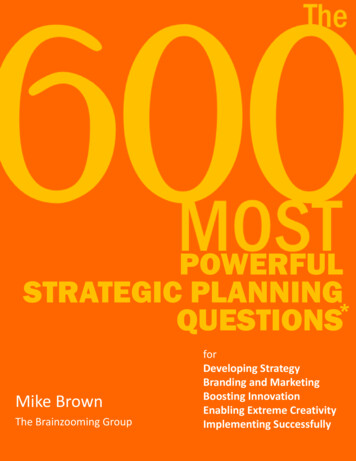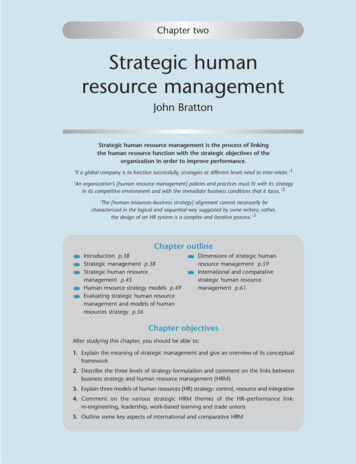
Transcription
The Strategic Importance of Stakeholder Management“Birds of a Feather” – Discussion NotesPMI – SAC Professional Development ConferenceNovember 24, 2009Prepared by:Sohail Thaker, Associate PartnerEthier Associates600, 736 - 6 Avenue S.W., Calgary, AB T2P 3T7Phone: (403) 234-8960Fax: (403) 234-8964www.ethierassociates.caEmail: info@ethierassociates.ca
Birds of a FeatherSession Topic InformationTopic Title:The Strategic Importance of Stakeholder ManagementTopic Description:Stakeholders make or break a project, and often Project Managers do not spend thetime to effectively manage the stakeholder relationship – to the project’sdisadvantage. This session will cover tips and techniques from the session host andwill solicit ideas.Facilitator Name:Sohail Thaker, MBA, PMPFacilitator Bio:Sohail Thaker is an Associate Partner with Ethier Associates. Sohail brings over 22years experience to the firm, with his last 10 years consulting with Ethier. He haspreviously worked in Africa, India and Europe, has an MBA and a PMP. Sohail hasextensive experience in project management (traditional, Agile and Scrum), programmanagement, business analysis, business process innovation, change management,and facilitation.Sohail has been managing projects for many years and has managed stakeholdersusing his understanding of how to identify and then meet their act “BOF” Discussion NotesPage 2
Understanding StakeholdersDiscussionStakeholders make or break a project, and often Project Managers do not spend the time to effectivelymanage the stakeholder relationship – to the project’s disadvantage. To be successful, Project Managersneed to learn how to leverage the stakeholder relationship and how to balance their competing needs.Stakeholders: DefinitionThe individuals and groups who depend on the Project to fulfill their own goals and on whom, in turn, theProject depends on, are called Stakeholders.oImportant to know about the differing expectations and differing definitions of project success thateach stakeholder possessoDetermine to what extent they could or would exert their influence?PoweroExtent that they are able to persuade, induce, or coerce others into following certain courses ofactionoExert power through direct authority, lobbying, or taking a positionSources of PoweroHierarchy – formal power, informal power, access to senior decision makersoControl of strategic resources (e.g. budget, people) and the relative percentage in comparison toothersoPossession of knowledge and skills (e.g. specialized information)oControl of the environment (e.g. physical, communications network in organization)oInvolvement in strategy implementation (e.g. participation in corporate direction setting)oRepresentation in powerful organizations (e.g. membership on influential committees)Group Discussion:oWhat are some of the status symbols that help us identify who has power?“BOF” Discussion NotesPage 3
Stakeholder ManagementPM Responsibilities re: Stakeholder ManagementoUnderstand stakeholdersoManage stakeholdersoMeet needs and expectations of stakeholdersoMaintain engagement - customize communication based on the aboveoPM needs to possess the following excellent and mature communication skills:oVerbaloUnambiguousoWrittenoAccurate, honest & completeoPresentationoAudience sensitiveoConcise / ClarityoCourageousDanger SignalsPMs – pay attention to Danger Signals from stakeholdersoInterference with project (without consulting with PM first)oNot providing support when neededoNot attending key meetingsoPoor communication – too many layers between PM and stakeholderoMaking unfounded commitments & promisesGroup Discussion:oWhat other “Danger Signals” should the PM be looking for?“BOF” Discussion NotesPage 4
Impact of Stakeholders on ProjectsProjectsoProjects are temporary endeavorsoGiven the organizational structure of projects, and the impact that stakeholders have on projects,Project Managers:ooHave little formal authority over stakeholdersoMust use personal power to influenceoAre responsible for regular, planned & ad-hoc communicationoMust establish a good relationship with the project sponsoroMust maintain ongoing relationships with stakeholdersTypical Project Organization StructureSTAKEHOLDERSProject OversightProject SponsorProject SteeringCommitteeProject TeamProject ManagerEXTERNALSTAKEHOLDERSBusiness LeaderTechnical LeaderSubject MatterExperts (SMEs)Technical ExpertsINTERNALSTAKEHOLDERS“BOF” Discussion NotesPage 5
oExamples of Internal vs. External StakeholdersInternal StakeholdersExternal StakeholdersProject SponsorCustomersFunctional Departments (e.g. Marketing, IT)Regulatory / GovernmentCorporate LeadershipCompetitorsOther Project TeamsJoint Venture PartnersEmployeesVendorsUnionsInvestors / ShareholdersoOrganization Structure - the project will tend to take on a structure and maturity similar to theorganization.oUnderstanding the corporate structure (and its stakeholders) can help when trying toidentify stakeholders for a project.oRecognize that the company organization structure is long-standing and is supported byestablished lines of communication, formal and informal. The project is temporary anddoes not have the advantage of these established lines of communication.PROJECT SPONSORSTEERINGCOMMITTEEPROJECT MANAGERBUSINESS LEADERI S LEADERPROJECT ORGANIZATIONCEO / CHAIRMANBOARDPRESIDENT or COOVPVPCOMPANY ORGANIZATION“BOF” Discussion NotesPage 6
Stakeholder AnalysisThe following diagram can be used to get an understanding of the stakeholders in terms of two metrics;Power and Level of Interest.“BOF” Discussion NotesPage 7
Stakeholder Analysis - Recommendations1) Use the above analysis technique to understand the current stakeholder landscape2) Identify current position and priority of stakeholdersoMay need to break large groups into smaller groups (e.g. IT)3) Identify supporters and opponentsoIdentify what each stakeholder needs/expects from the project, risk tolerance, level of support,agenda for support or opposition4) Determine if repositioning is required?oIf repositioning a stakeholder is required - determine what needs to be done to shift power?oe.g. Involve stakeholder in early stages of planningoe.g. Invite stakeholder group - team members to key planning meetings5) Maintain engagementoSimilar to risk management, use this analysis when planning stakeholder communicationoPrepare specific communication strategy per group6) Maintain currencyoUpdate the stakeholder analysis for each stage of the projectoUpdate to reflect changes to the stakeholders (e.g. people leaving, added)7) Critical stakeholders / steering Committee – train on roles & responsibilitiesoIf stakeholders are on the Steering Committee - help them understand their roleoProvide them with training on project governance/oversight so they can be successfuloDon’t assume they know how to oversee a projectGroup Discussion:oWhat challenges have you faced with managing stakeholders?oHow do you manage stakeholders that are in resistance?oWhat skills have you seen, are necessary, to successfully manage the stakeholders?“BOF” Discussion NotesPage 8
2575C8007B4540/ a.org/wiki/Stakeholder theoryhttp://www.mosaicprojects.com.au/PDF Papers/P010 Stakeholder Circle.pdf“BOF” Discussion NotesPage 9
extensive experience in project management (traditional, Agile and Scrum), program management, business analysis, business process innovation, change management, and facilitation. Sohail has been managing projects for many years and has managed stakeholders using his understan


